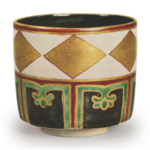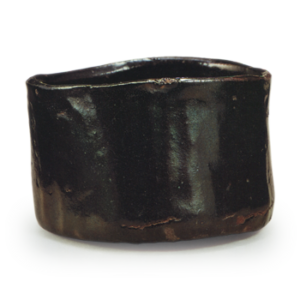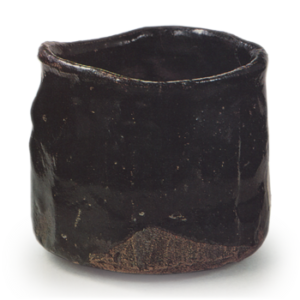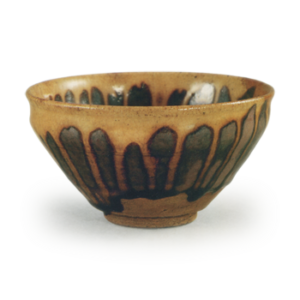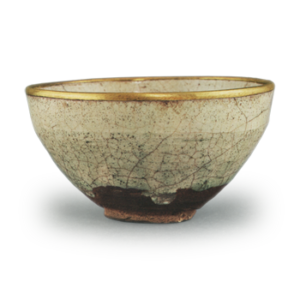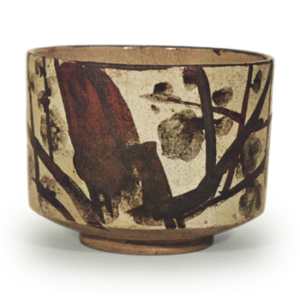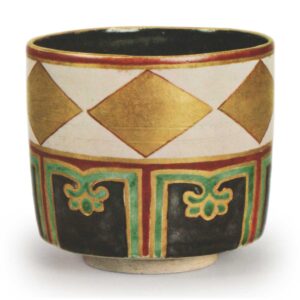
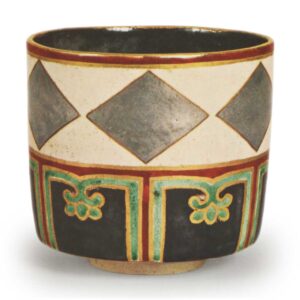
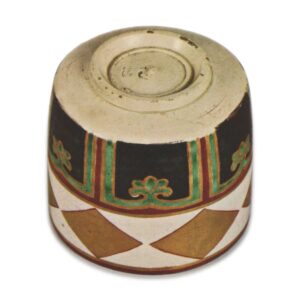
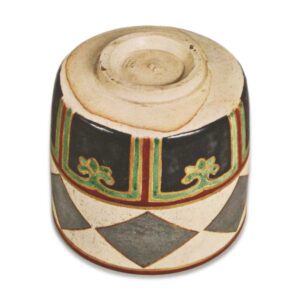
Collection: Atami Museum of Art
Height: 8.0 – 8.1 cm
Diameter: 8.7 – 9.0 cm
Foot diameter: 4.9 cm
Height at same point: 0.5 cm
These tea bowls are made in a large and small nested configuration, and the diamond pattern on the body of each is made of gold and silver, so they are called “gold and silver diamond tea bowls”. They are the highlight of Nisei’s colored tea bowls, and are very impressive.
By the way, this tea bowl is unique in that it is made in a nested form, and the idea of nesting a ceramic cylindrical tea bowl is a technique that is truly characteristic of Sowa and Ninshō. Furthermore, the truly elegant form of this tea bowl is something that an ordinary potter would not be able to achieve.
Even though it is common to use gold and silver in the design of nested tea bowls, the fact that this is expressed in a diamond pattern and surrounded by a lotus petal pattern at the hem, and the beauty of the color scheme, with the upper half of the body , the brilliant harmony of the patterns and colors – gold or silver and red on a white background for the upper half, gold and green on a black background for the lower half, and a black interior – is truly a vivid expression of the Kyoto style, and it can be said that this was a work that only Ninshō pottery could have produced.
Both large and small, these tea bowls have a slightly constricted body and a slightly open mouth, but the slight bulge gives them an indescribably soft appearance.
The entire surface, with the exception of the outer base, is covered in Nisei’s characteristic cloudy white glaze. Therefore, the black glaze on the inside and at the base is layered on top of the cloudy white glaze, and the surface of the black glaze is not jet black, but rather has a faintly hazy, white appearance. The lotus petal pattern on the foot is not painted on top of the black glaze, but is made up of black, gold and green, and the gold and silver diamond pattern on the body looks at first glance like it has been painted with gold leaf, but it is actually made by applying gold and silver clay thickly.
The bottom of the foot ring is usually open in many of Nisen’s tea bowls, but in this case, both the large and small bowls have a transparent glaze, perhaps because the tea bowls were made with nested bowls in mind. The glaze is very thin, so as not to lose the texture of the clay, and it seems to have been applied with the care that would be expected of a special order item. It is clear that the foot of the small bowl was used to prevent the glaze on the inside of the large bowl from being scratched, and it is thought that the glaze was applied to the large bowl as well because the small bowl alone would not have been in harmony with it. The “Ninsei” seal is stamped on the left side of the foot, as is usual, and there is a small hood in the center.
It is said that this tea bowl was made as a personal item for Tofukumon-in and was a favorite of Kanamori Sowa, and later it was given to Doi Sagami-no-kami, and since then it has been passed down in the same family, but when the Doi family was liquidating their belongings at the beginning of the Meiji era, it was purchased by Yamazumi Rikizo, a Tokyo-based dealer, for 10 yen, and it is said that he was at a loss for a long time because he had no buyers. It then passed into the hands of Kamenosuke Hirase of Osaka, and in 1902, when the family’s collection was auctioned off, it was purchased by Ben’en Masuda for over 5,000 yen. It later passed into the hands of Nobuyo Masuda, it was highly valued among tea ceremony enthusiasts as a Nisen tea bowl in the Masuda family collection, but after the Pacific War, it left the family and came into the possession of Shokichi Okada, and was then transferred to the World Messianic Church, where it is now kept in the Atami Museum of Art.
There is no documentary evidence to support the story that Kanamori Sowa had this tea bowl made especially for Tofukumon’in, but perhaps it was passed down in the Doi family as a gift from the empress. Or perhaps the tea bowl’s elegant beauty and the fact that it came from the empress led to the idealistic connection between Tofukumon’in, Kanamori Sowa and Ninshō being talked about over time.

